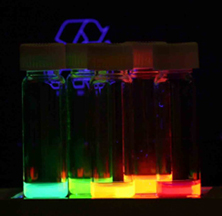|
Crosslight Software
Crosslight Software Inc. is an international company headquartered in greater Vancouver, British Columbia, Canada. Officially spun off from the National Research Council of Canada (NRC) in 1995, it provides Technology Computer Aided Design ( TCAD) tools for semiconductor device and process simulations. Crosslight's founder, Dr. Z.M. Simon Li (李湛明), is a pioneer in the field of optoelectronic device simulation TCAD and based on this work, Crosslight claims to be the first commercial vendor of TCAD tools for quantum well laser diodes. Crosslight also licenses other technology from the Stanford UniversityTCAD Groupfor semiconductor process simulations. History After its initial spin-off from the NRC, Crosslight launched its flagship product LASTIP, a 2D simulator for quantum well laser diodes. Based on its founder's research, LASTIP predates other well-known tools in the field such as MINILASE. By adding the ability to model quantum well active regions, LASTIP was al ... [...More Info...] [...Related Items...] OR: [Wikipedia] [Google] [Baidu] |
Private Company
A privately held company (or simply a private company) is a company whose shares and related rights or obligations are not offered for public subscription or publicly negotiated in the respective listed markets, but rather the company's stock is offered, owned, traded, exchanged privately, or over-the-counter. In the case of a closed corporation, there are a relatively small number of shareholders or company members. Related terms are closely-held corporation, unquoted company, and unlisted company. Though less visible than their publicly traded counterparts, private companies have major importance in the world's economy. In 2008, the 441 largest private companies in the United States accounted for ($1.8 trillion) in revenues and employed 6.2 million people, according to ''Forbes''. In 2005, using a substantially smaller pool size (22.7%) for comparison, the 339 companies on '' Forbes'' survey of closely held U.S. businesses sold a trillion dollars' worth of goods and services ... [...More Info...] [...Related Items...] OR: [Wikipedia] [Google] [Baidu] |
Light-emitting Diode
A light-emitting diode (LED) is a semiconductor device that emits light when current flows through it. Electrons in the semiconductor recombine with electron holes, releasing energy in the form of photons. The color of the light (corresponding to the energy of the photons) is determined by the energy required for electrons to cross the band gap of the semiconductor. White light is obtained by using multiple semiconductors or a layer of light-emitting phosphor on the semiconductor device. Appearing as practical electronic components in 1962, the earliest LEDs emitted low-intensity infrared (IR) light. Infrared LEDs are used in remote-control circuits, such as those used with a wide variety of consumer electronics. The first visible-light LEDs were of low intensity and limited to red. Early LEDs were often used as indicator lamps, replacing small incandescent bulbs, and in seven-segment displays. Later developments produced LEDs available in visible, ultraviolet ... [...More Info...] [...Related Items...] OR: [Wikipedia] [Google] [Baidu] |
Semiconductor Optical Amplifier
An optical amplifier is a device that amplifies an optical signal directly, without the need to first convert it to an electrical signal. An optical amplifier may be thought of as a laser without an optical cavity, or one in which feedback from the cavity is suppressed. Optical amplifiers are important in optical communication and laser physics. They are used as optical repeaters in the long distance fiberoptic cables which carry much of the world's telecommunication links. There are several different physical mechanisms that can be used to amplify a light signal, which correspond to the major types of optical amplifiers. In doped fiber amplifiers and bulk lasers, stimulated emission in the amplifier's gain medium causes amplification of incoming light. In semiconductor optical amplifiers (SOAs), electron-hole recombination occurs. In Raman amplifiers, Raman scattering of incoming light with phonons in the lattice of the gain medium produces photons coherent with the incoming p ... [...More Info...] [...Related Items...] OR: [Wikipedia] [Google] [Baidu] |
K·p Perturbation Theory
In solid-state physics, the k·p perturbation theory is an approximated semi-empirical approach for calculating the band structure (particularly effective mass) and optical properties of crystalline solids. It is pronounced "k dot p", and is also called the "k·p method". This theory has been applied specifically in the framework of the Luttinger–Kohn model (after Joaquin Mazdak Luttinger and Walter Kohn), and of the Kane model (after Evan O. Kane). Background and derivation Bloch's theorem and wavevectors According to quantum mechanics (in the single-electron approximation), the quasi-free electrons in any solid are characterized by wavefunctions which are eigenstates of the following stationary Schrödinger equation: :\left(\frac+V\right)\psi = E\psi where p is the quantum-mechanical momentum operator, ''V'' is the potential, and ''m'' is the vacuum mass of the electron. (This equation neglects the spin–orbit effect; see below.) In a crystalline solid, ''V'' is ... [...More Info...] [...Related Items...] OR: [Wikipedia] [Google] [Baidu] |
Quantum Dot
Quantum dots (QDs) are semiconductor particles a few nanometres in size, having optical and electronic properties that differ from those of larger particles as a result of quantum mechanics. They are a central topic in nanotechnology. When the quantum dots are illuminated by UV light, an electron in the quantum dot can be excited to a state of higher energy. In the case of a semiconducting quantum dot, this process corresponds to the transition of an electron from the valence band to the conductance band. The excited electron can drop back into the valence band releasing its energy as light. This light emission (photoluminescence) is illustrated in the figure on the right. The color of that light depends on the energy difference between the conductance band and the valence band, or the transition between discrete energy states when band structure is no longer a good definition in QDs. In the language of materials science, nanoscale semiconductor materials tightly confine either ... [...More Info...] [...Related Items...] OR: [Wikipedia] [Google] [Baidu] |
Quantum Wire
In mesoscopic physics, a quantum wire is an electrically conducting wire in which quantum effects influence the transport properties. Usually such effects appear in the dimension of nanometers, so they are also referred to as nanowires. Quantum effects If the diameter of a wire is sufficiently small, electrons will experience quantum confinement in the transverse direction. As a result, their transverse energy will be limited to a series of discrete values. One consequence of this quantization is that the classical formula for calculating the electrical resistance of a wire, : R = \rho \frac, is not valid for quantum wires (where \rho is the material's resistivity, l is the length, and A is the cross-sectional area of the wire). Instead, an exact calculation of the transverse energies of the confined electrons has to be performed to calculate a wire's resistance. Following from the quantization of electron energy, the electrical conductance (the inverse of the resistance) is fo ... [...More Info...] [...Related Items...] OR: [Wikipedia] [Google] [Baidu] |
Quantum Well
A quantum well is a potential well with only discrete energy values. The classic model used to demonstrate a quantum well is to confine particles, which were initially free to move in three dimensions, to two dimensions, by forcing them to occupy a planar region. The effects of quantum confinement take place when the quantum well thickness becomes comparable to the de Broglie wavelength of the carriers (generally electrons and holes), leading to energy levels called "energy subbands", i.e., the carriers can only have discrete energy values. A wide variety of electronic quantum well devices have been developed based on the theory of quantum well systems. These devices have found applications in lasers, photodetectors, modulators, and switches for example. Compared to conventional devices, quantum well devices are much faster and operate much more economically and are a point of incredible importance to the technological and telecommunication industries. These quantum well devic ... [...More Info...] [...Related Items...] OR: [Wikipedia] [Google] [Baidu] |
Thin Film Solar Cell
A thin-film solar cell is a second generation solar cell that is made by depositing one or more thin layers, or thin film (TF) of photovoltaic material on a substrate, such as glass, plastic or metal. Thin-film solar cells are commercially used in several technologies, including cadmium telluride (CdTe), copper indium gallium diselenide (CIGS), and amorphous thin-film silicon (a-Si, TF-Si). Film thickness varies from a few nanometers ( nm) to tens of micrometers (µm), much thinner than thin-film's rival technology, the conventional, first-generation crystalline silicon solar cell (c-Si), that uses wafers of up to 200 µm thick. This allows thin film cells to be flexible, and lower in weight. It is used in building-integrated photovoltaics and as semi- transparent, photovoltaic glazing material that can be laminated onto windows. Other commercial applications use rigid thin film solar panels (interleaved between two panes of glass) in some of the world's largest ph ... [...More Info...] [...Related Items...] OR: [Wikipedia] [Google] [Baidu] |
Acceleware
Acceleware Ltd. (TSX-V: AXE) is a Canadian innovator of clean-tech oil and gas technologies composed of two business units: Radio Frequency (RF) Enhanced Oil Recovery and Seismic Imaging Software. The company is currently running a commercial-scale, RF XL pilot project at Marwayne, Alberta, Canada, to advance and validate its heavy oil and oil sands electrification technology. Acceleware's seismic imaging software solutions offer imaging for oil exploration in complex geologies. Acceleware is part of a larger computing industry trend towards parallel processing via multi-core and massively-parallel GPU hardware and software architectures. Acceleware software can be used in the following industries: electromagnetics, oil and gas, medical imaging, security imaging, industrial product design, consumer product design, financial research, and academic research. History Acceleware was founded in 2004, in Calgary, Alberta, Canada. Extensive research on special-purpose hardware was c ... [...More Info...] [...Related Items...] OR: [Wikipedia] [Google] [Baidu] |
Solar Cell
A solar cell, or photovoltaic cell, is an electronic device that converts the energy of light directly into electricity by the photovoltaic effect, which is a physical and chemical phenomenon.Solar Cells chemistryexplained.com It is a form of photoelectric cell, defined as a device whose electrical characteristics, such as current, voltage, or , vary when exposed to light. Individual solar cell devices are often the electrical building blocks of [...More Info...] [...Related Items...] OR: [Wikipedia] [Google] [Baidu] |
Burnaby
Burnaby is a city in the Lower Mainland region of British Columbia, Canada. Located in the centre of the Burrard Peninsula, it neighbours the City of Vancouver to the west, the District of North Vancouver across the confluence of the Burrard Inlet with its Indian Arm to the north, Port Moody and Coquitlam to the east, New Westminster and Surrey across the Fraser River to the southeast, and Richmond on the Lulu Island to the southwest. Burnaby was incorporated in 1892 and achieved its city status in 1992. A member municipality of Metro Vancouver, it is British Columbia's third-largest city by population (after Vancouver and Surrey), and is the seat of Metro Vancouver's regional district government. 25% of Burnaby's land is designated as parks and open spaces, one of the highest in North America. The main campuses of Simon Fraser University and the British Columbia Institute of Technology are located in Burnaby. It is home to high-tech companies such as Ballard Power ... [...More Info...] [...Related Items...] OR: [Wikipedia] [Google] [Baidu] |



